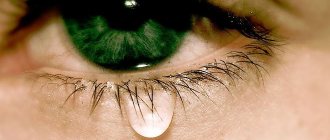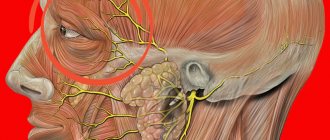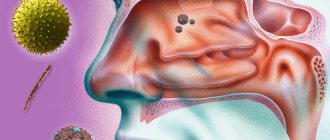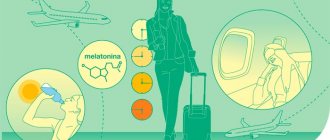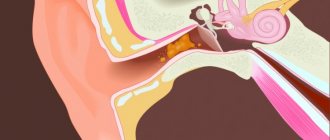The eyes often hurt due to overstrain and fatigue, but unpleasant sensations also indicate inflammatory and infectious processes. Medicines and folk remedies will help cope with the discomfort; in the absence of timely therapy, complete or partial loss of vision develops.
Find out the true cause to eliminate eye discomfort
Causes of eye pain
Injuries, inflammatory processes, and overexertion are most often accompanied by pain, burning and stinging in the eyes. The problem affects one or both organs of vision.
A child under 6 months of age is diagnosed with complete or partial obstruction of the lacrimal duct - pain in the corner of the eye is accompanied by swelling, lacrimation, and redness of the organ of vision.
Ophthalmic diseases are the main cause of eye pain:
- Conjunctivitis is an inflammation of the mucous membrane of the eyes that develops against the background of allergies, viral and bacterial infections. Cutting pain, tingling, increased sensitivity to light, lacrimation, redness of the whites and conjunctiva, discharge with mucus and pus - the main symptoms of the disease, intensify when a person closes his eyes.
- Keratitis is an inflammation of the cornea that occurs after injury, sometimes indicating the development of influenza and tuberculosis. The eyes sting and cut, the pain is acute, prolonged, there is clouding of the cornea, photophobia.
- Cataracts are a disease that occurs more often in older people and diabetics. There is no pronounced pain syndrome; minor discomfort may occur due to constant tension against the background of sharply deteriorating vision.
- Trachoma is an infectious viral ophthalmological pathology of the orbit, transmitted through household contact. The pain is dull, moderate, but as the disease progresses, the discomfort intensifies, it is always bilateral, the eyes in the corners of the eyes near the bridge of the nose become very red, and pus is released.
- Glaucoma - an increase in intraocular pressure is accompanied by attacks of sharp intense pain, the person feels sick, and sometimes hospitalization is required. Additional symptoms are deterioration, blurred vision, headache.
- Astigmatism is a disorder of the optical system; a person sees everything blurry. Sharp discomfort in the eyes is accompanied by a severe headache, which intensifies when pressed.
- Blepharitis is an inflammation of the tissues of the eyelids, develops with infectious, endocrine diseases, can be caused by vitamin deficiency, often occurs in adults and children who live in poor sanitary and hygienic conditions. When the disease occurs, there is a feeling of the constant presence of dust, sand in the eyes, the organs of vision quickly get tired, photophobia is observed, the eyelids become red, swollen, and hurt.
- Barley is a one-sided disease; an acute purulent inflammation develops in the hair follicle or sebaceous gland. The pain syndrome is acute, especially at the initial stage of the disease, the eyelids itch, swell, the eyes turn red, an abscess bulges, and sometimes the temperature rises.
Conjunctivitis is a common cause of eye pain.
The eyes become hot and watery with a cold, all viral and bacterial diseases that are accompanied by high fever and vomiting. In this case, a person experiences a runny nose, cough, headache, dyspeptic disorders, and discomfort in the eyes usually disappears on its own within 1–2 days.
Other causes of eye pain
Unpleasant sensations in the eyes occur not only with ophthalmological problems, but also with diseases of other internal organs.
What diseases are accompanied by eye pain:
- Shingles - severe pain without additional symptoms, redness and small ulcers gradually appear.
- Chronic pathologies of an infectious nature of the paranasal sinuses - prolonged, but not severe discomfort in the forehead, corners of the eyes near the bridge of the nose appears at the time of exacerbation of the disease.
- Migraine, temporal arteritis - unpleasant sensations in the eyes occur against the background of vasospasm, the pain is sudden, accompanied by double vision, flashing spots or colored spots, weakness, subsides as the manifestations of the underlying disease are eliminated.
- Inflammation of the trigeminal, facial nerve - the disease is accompanied by a pronounced pain syndrome of a pulsating nature, discomfort covers one eye, temple, cheek.
- Periarteritis nodosa, lupus erythematosus, other systemic pathologies in which the vessels are affected - the nutrition of the eyeball is disrupted, the pain is constant.
- Pain and aching in the eyes with cervical osteochondrosis is a consequence of impaired arterial circulation, the discomfort intensifies when you close your eyes in the morning.
- An increase in intracranial and blood pressure results in dull pain in the eyes.
Shingles causes eye pain
Dry eye syndrome is a common consequence of injuries, prolonged work at the computer or watching TV.
Red eyes in the evening happen to jewelers, watchmakers, and other people who constantly have to strain their eyes at work or be in a room with air conditioning or fluorescent lamps.
Burning and stinging occurs in the eyes when you move them, accompanied by the presence of sand in the eye and difficulty blinking.
Injuries, squeezing of the eye, impact with a blunt object lead to bruising, unpleasant sensations manifest themselves in the form of sharp, intense pain, swelling of nearby tissues, bruising, the damaged organ turns red, and burst capillaries are noticeable.
It stings like a needle - similar discomfort is caused by the presence of dust particles and specks; after removing the foreign body, the irritating symptoms disappear on their own within a few hours.
Mechanical pain in the eyes occurs when wearing lenses or glasses for a long time; unpleasant sensations can occur if the diopters and alignment are incorrectly selected.
If your eyes hurt when you have a cold or flu, what should you do?
The most common cause of eye pain due to a cold or flu is sinusitis or inflammation of the paranasal sinuses. This is a consequence of the underlying disease, which leads to swelling of the nasal septum and increased mucus production. As a result, the passages to the paranasal sinuses are filled with it, which causes excess pressure and pain. The movement of mucus and air between the sinuses and nose is also difficult.
Antibacterial drugs can help cope with this cause of discomfort. In general, sinusitis is not dangerous for the organs of vision, despite the proximity of the source of infection to the eyes, and rarely leads to serious diseases. However, it does cause discomfort. In addition, pain in the eyes during a cold is often accompanied by tearing. As sinusitis progresses, the patient may find it difficult to tolerate bright light. To reduce discomfort, drops should be used and compresses should be made, for example, with a herbal decoction. But getting rid of pain is only possible if the cause is eliminated, so you need to treat the cold or flu that caused it. To reduce discomfort in the eye area, you must try not to create excess pressure: carefully clear the mucus from your nose, alternately pinching your nostrils.
Which doctor should I contact?
An ophthalmologist is involved in the diagnosis, treatment of eye diseases, and the selection of lenses and glasses, if necessary. If pain in the organs of vision is caused by pathologies of internal organs, you will need to consult an infectious disease specialist, neurologist, ENT specialist, or surgeon.
If you have eye pain, consult an ophthalmologist
Important! Sharp pain, severe redness, inability to open the eyes are a consequence of a burn to the cornea during welding, sun rays; in case of serious injury, long-term treatment will be required; vision deteriorates due to tissue necrosis.
Your eyes hurt when you move them, when you turn them - what is it?
Pain when moving the eyes can be caused by extraocular and ocular causes. The first group includes diseases such as colds, sinusitis, and migraines. They cause severe intoxication of the body. As a result, complications such as conjunctivitis and scleritis appear, the negative impact manifests itself in the form of pain in the extraocular muscles. Often the infection damages the nerve endings, which leads to discomfort. They intensify with movement.
Eye pain can be caused by blepharitis, oculomotor neuritis, myositis and glaucoma. With blepharitis, the tissues of the eyelid become inflamed, so it not only causes pain in the eyes when moving, but also their redness and swelling. Neuritis of the oculomotor nerve is very rare. It is difficult to make such a diagnosis on your own; only an experienced ophthalmologist can do this, and consultation with a neurologist is also necessary.
With myositis, the muscles that cause the eyeball to move become inflamed. Treatment for this disease involves avoiding menial work. In this way, it is possible to relieve tension and minimize pain that appears and intensifies when moving the eyes. You can also make a compress using tea bags. The most serious cause of discomfort when moving the eyes is glaucoma. You should consult an ophthalmologist with this disease, as it can lead to complete loss of vision. The sooner treatment is started, the greater the chance of maintaining it.
Diagnostic methods
It is difficult to make a diagnosis based only on an external examination, since most ophthalmological pathologies have a similar clinical picture; the true cause of discomfort can be identified after a thorough examination.
Main types of research:
- visometry – testing visual acuity;
- checking visual fields, peripheral vision;
- ophthalmoscopy – examination of the fundus, retina, optic nerves and blood vessels;
- measurement of intraocular pressure;
- pachymetry – assessment of corneal thickness;
- Ultrasound of the organs of vision;
- examination of the cornea using special staining solutions;
- keratotopography – allows you to evaluate the curvature and refraction of the cornea;
- determining the amount of tears produced;
- neuroradiography;
- studying the condition of the retina - medications are first instilled to dilate the pupil.
When diagnosing eye problems, a visual acuity test is required.
If eye diseases develop against the background of other pathologies, a clinical blood test, studies of the vascular, nervous system, and MRI of the brain are prescribed.
Eye diagnostics do not cause much discomfort, but when measuring intraocular pressure in children, if the patient has blepharospasm and photophobia, local anesthesia is used.
My left temple and left eye hurt
In the modern world, headaches are a common companion for humans. This is a common symptom of many diseases . We strive to get rid of pain, we take painkillers. But this is a temporary measure. If you don't understand the cause and don't eliminate what causes the pain, it comes back again and again .
Photo 1: Sometimes pain is localized in the area of the left eye and at the same time radiates to the left temporal region. Unilateral pain is usually characteristic of diseases of the nervous system or occurs due to problems with the spine and a number of other serious diseases. Source: flickr (Eugene Evehealth).
Medicines
When treating ophthalmological pathologies, drops with various therapeutic effects are used; if eye problems are secondary, the underlying disease is treated.
What drops are used to relieve eye pain:
- antibacterial - Tobrex, Tsiprolet;
- moisturizing – Oftagel, Oksial;
- antiviral - Poludan, Aktipol;
- complex action – Albucid, Sofradex;
- eye antiseptics – Miramistin, Avitar;
- anti-inflammatory – Naklof, Voltaren ofta;
- hormonal – Prednisolone, Betamethasone;
- antihistamines – Azelastine, Opatanol;
- vasoconstrictors – Visin, Naphazoline;
- vitamins – Katalin, Taufon;
- to reduce intraocular pressure – Xalatan, Azopt;
- for the treatment and prevention of cataracts - Taurine, Mezaton.
Drug therapy is based on regular treatment with eye drops with the desired effect
After opening, all drops should be stored, strictly following the instructions; before use, hold the bottle in your hands a little to warm the liquid.
Important! In case of obstruction of the lacrimal canal in children, at the initial stage, drug treatment and physiotherapy are used; in advanced cases, simple surgical intervention is required.
Treatment with folk remedies
Non-traditional treatment methods help to quickly cope with swelling, redness, itching of the eyes, and reduce the manifestations of the inflammatory process.
Simple recipes to get rid of eye pain:
- Brew 1 tsp in 200 ml of boiling water. black and green tea, chamomile inflorescences, leave for 10–15 minutes, filter. Soak cotton pads in the solution, apply to the eyes for a quarter of an hour, carry out the procedure 3-5 times a day, if the eye is swollen and watery.
- Pour 3 tbsp into a thermos. l. chopped brown algae, pour 300 ml of water, leave overnight, strain, freeze in ice cubes. It’s not scary to wipe the skin around the eyes in the morning and evening if the infusion gets on the mucous membrane. The product helps to cope with pain due to excessive stress on the organs of vision, increases tissue resistance to pathogenic microorganisms, and prevents vision loss.
- Mix 5 g of cornflower inflorescences and plantain leaves, add 10 g of crushed cumin seeds, pour 250 ml of boiling water over the collection, leave in a sealed container for 3 hours, strain. Instill 3 drops of the medicine into each eye every 4-5 hours; the product helps with inflammation and eye fatigue.
- Peel and chop aloe leaves, pour 20 g of puree into 200 ml of boiling water, cool, strain. Moisten cotton pads and apply to the eyes for 20 minutes 2-4 times a day, the medicine eliminates the manifestations of conjunctivitis.
- For barley, apply a little warm homemade yogurt on a fresh plantain leaf and hold the compress for 10–15 minutes.
Make compresses to relieve eye pain with various herbs, depending on the cause of its occurrence.
For astigmatism, conjunctivitis, and to prevent eye diseases, take 2 glasses of a drink made from equal parts of spinach and carrot juice.
Eye pain (causes): treatment
Specific treatment methods and drug names are determined by the doctor based on the identified pathology. Treatment in the vast majority of cases is conservative and consists of local use of drugs (in the form of drops and ointments). In severe cases of glaucoma, surgical treatment may be prescribed.
The following groups of drugs are prescribed:
• Antibacterial drugs (antibiotics) . Prescribed for all types of infectious lesions of the eye media. Helps the immune system cope with pathogens. The form is different: ointments, drops.
• Drugs for eye fatigue . They are practically not prescribed by doctors, since the therapeutic value of such drugs is questionable, and a huge number of contraindications have been found. The popular Vizin drops and others like them are dangerous: they have a vasoconstrictor effect, impair the outflow of fluid and nutrition of the eyes. Their use is fraught with serious consequences.
• Drugs for corneal trauma. Traumatic factors, even minor ones, violate the integrity of the tissues of the eye: the cornea and conjunctiva, which is manifested by swelling, redness, pain and burning, and the sensation of a foreign body in the eye. To restore eye tissue after injury, products containing dexpanthenol, a substance characterized by a regenerating effect on tissue, have proven themselves to be effective, in particular, the Korneregel eye gel. It has a healing effect due to the maximum concentration of dexpanthenol 5%*, and the carbomer included in its composition, due to its viscous texture, prolongs the contact of dexpanthenol with the ocular surface.
• Anti-inflammatory drops . To relieve discomfort caused by inflammation. In uncomplicated clinical cases, doctors prescribe Diclof, Indocollir (at the same time a pain reliever), etc.
• Painkillers . The use of analgesics is practiced to relieve discomfort.
• Drugs to combat glaucoma . They include a whole range of tools. They are selected only by a doctor and strictly based on the characteristics of the patient’s body and the course of the pathology.
• Antihistamines . Prescribed in combination with analgesics and anti-inflammatory drugs for proven allergic etiology of eye problems.
Possible consequences and complications
Lack of therapy or improper treatment of ophthalmological diseases is fraught with complete or partial loss of vision; the diseases progress quickly, which makes a person nervous.
Why are eye diseases dangerous?
- if trachoma keratitis is not treated, follicles, cataracts, and ulcers form;
- decreased vision, development of secondary blindness;
- turning of the eyelids;
- strabismus;
- secondary astigmatism develops against the background of trauma.
Strabismus may result from untreated eye diseases
Infectious and inflammatory processes respond well to treatment; with timely treatment, complications rarely occur. For injuries, burns and bruises, the likelihood of successful recovery and recovery depends on the extent of the damage.

